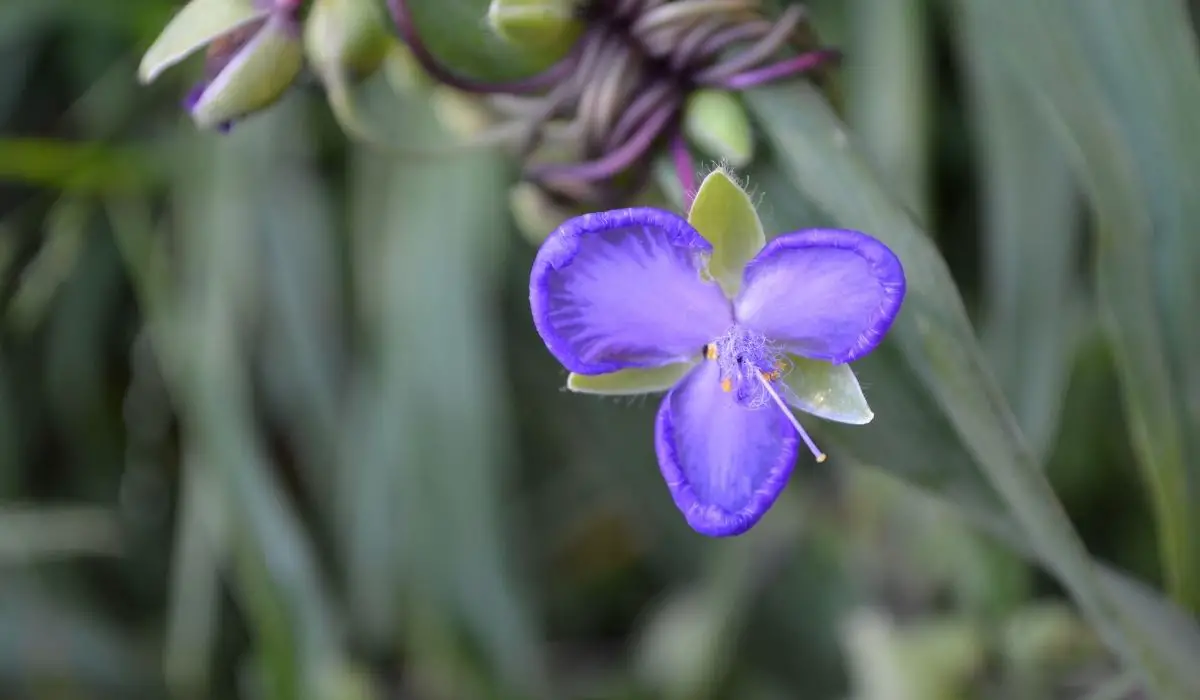Last Updated on November 29, 2021 by
It is critical for every gardener to learn when to cut back spiderwort to allow it time to heal, regrow and bloom again.
Spiderwort is a much-loved garden flower that brings lovely blue, pink, and purple shades to your landscape. These flowers bloom starting from spring to early summer, and they are easy-going plants.
Spiderworts look nothing like spiders and do not attract any of these eight-legged insects to your garden. One theory among many why this plant was named Spiderwort is that it was used as a remedy for spider bites.
Let us learn more about the lovely spiderwort plant, how to grow and take care of it.
When To Cut Back Spiderwort
Cutting back spiderwort encourages them to bloom again before the season is over. They will often bloom in late summer to early fall if you cut them back in midsummer after their first bloom dies.
The Missouri botanical garden recommends cutting back your spiderwort plant almost to the ground after the foliage fades and the temperatures get hot. During this season of dryness, spiderwort foliage turns brown, but the plants do not die.
It is essential to cut your spiderwort back to about 6 inches and provide supplemental water to revive its new growth. After the bloom period is over, the spiderwort plant looks completely rugged. Cutting it back is a solution that serves two purposes.
- First, it stops the spiderwort plant from self-sowing and becoming weedy
- Second, pruning spiderwort by 1/3 reinvigorates the plant increasing its chances of producing late-season blooms and making it more beautiful for the rest of the season.
Dormant Season Spiderwort Cut Back
In late fall and early winter, the spiderwort growth slows down, and the flowering stops. When the freezing weather sets in, the existing foliage dies back. To keep your garden neat and remove the dead foliage, it is best to prune your plant.
There is no specific time when you should remove the old foliage. Cut it back in the fall or leave the old foliage in place to remove it at the start of spring before new growth occurs.
Spiderwort Companion Plants
You can grow several plants together with spiderwort. They include:
Lady’s Mantle
Lady’s mantle looks magnificent in the garden and the vase. Its colored leaves can catch dew drops or rain making them look like they are dusted with jewels. The flowers appear in playful frothy clusters above the foliage and are best grown around the edges of a shaded part of an excellent ground cover in dappled shade.
Coreopsis
Coreopsis is one of the longest bloomers in the garden producing sunny yellow daisy-like flowers that attract butterflies. Depending on its variety, this flower bears pale yellow, golden yellow, pink or bi-color flowers. It blooms from early to mid-summer or longer as long as you deadhead it.
Loosestrife
These vibrant growing flowers are beautiful additions to your garden. They are tall stately plants best for borders and creeping ground covers.
The flowers are tight spikes of ½ an inch to 1-inch pipes carried alone or in whorls. These flowers enjoy humus-rich moisture-retentive soil, while some enjoy wet soil and plenty of water.
Some of the loosestrifes may become invasive if not controlled early enough. Please note that these are not the invasive purple loosestrife that has been banned in many parts of the United States.
Spiderwort Cut And Regrow Care
Spiderwort produces charming continuous blooms and requires relatively straightforward care. This plant grows in clumps making it ideal for the edges of your garden.
It thrives in moist but well-drained soils and is an unfussy plant thriving in sunny and partially shady areas. No deadheading is necessary for these flowers to achieve repeated blooming. Other care includes
Light
Spiderwort is not overly fussy, but it loves sunlight. Even though it prefers partial sunlight or partial shade, it does well in almost any environment as long as it gets at least a few hours of light every day. That said, choose a sunnier spot for your spiderwort if you hope to achieve a bright blooming plant.
Soil
Spiderwort can grow in any soil condition as long as it is well-draining and moist. It thrives best in humus soil that has a slightly acidic pH of 5.0 to 6.0.
The plant tends to clamp and sprawl as it grows, so it’s best planted at least 4 to 6 inches deep in the soil in the spring. Allow it enough room at least a foot between each plant to spread.
Water
Spiderwort is a drought-tolerant plant. However, it thrives best in moist soils and should be watered every few days, especially during the hot summer months.
If you live in an area that receives frequent summer storms, chances are your natural environment will provide enough rain to keep your plant happy.
Spiderwort plants grown in containers should receive water frequently, as they are less likely to retain enough moisture.
Temperature In Humidity
When it comes to temperature and humidity conditions, spiderwort is not a picky plant. It adapts to a range of hardiness zones and tolerates various temperatures, allowing it to thrive from early spring to late summer.
Spider what plants like moisture they do well in humid areas but do not require any added humidity if it’s not naturally present.
Fertilizer
If you are trying to grow spiderwort indoors, it is best to fertilize it. You can apply a balanced liquid fertilizer once a month to any spiderwort potted plant.
Spiderwort plants growing outdoors do not need much fertilizer; the plant can survive on one or two applications in early spring or the beginning of its growth.
If you would like to add some nutrients to your plant in the summer season, you can use compost or old manure added to your soil mixture.
Conclusion
Whether you want it as a houseplant or landscaping, there is a lot to love about spiderwort. If you are worried about it becoming too aggressive, grow it in containers to monitor it and divide it often.
And now that you understand the right time to cut the spiderwort plant, your gardening becomes easier.
Read more about When To Apply Fertilizer To Vegetable Garden.
Caroline is a gardener who loves to get down to the nitty–gritty of gardening. She proudly proclaims herself as a ‘dirt worshipper‘ and can often be found deep in the garden, covered in soil and singing to her plants. As a self–proclaimed ‘plant whisperer‘, Caroline believes that plants need love and attention just like any other living thing, and she loves to give them both. When she‘s not tending to her garden, you can often find her researching the latest gardening trends, or teaching others how to make their gardens thrive



